#syngnathus
Explore tagged Tumblr posts
Text

Bay Pipefish (Syngnathus californiensis), family Syngnathidae, order Syngnathiformes, found in ell grass beds along the Western Coast of North America, from Alaska to Baja California, Mexico
photograph via: California Academy of Sciences
#syngnathus#pipefish#biny fish#fish#ichthyology#ocean#syngnathidae#syngnathiformes#animals#nature#north america
349 notes
·
View notes
Note
I want a fish!! Give me a silly one!
Fish version of a work on a string

You get a Northern Pipefish
Syngnathus fuscus
107 notes
·
View notes
Text

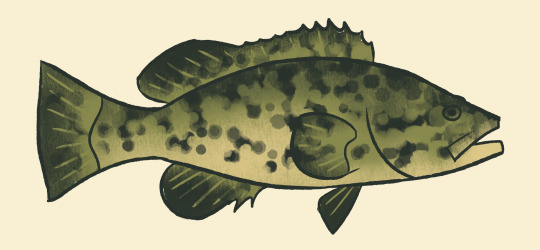
54 common fish of texas, part 9: gulf pipefish (Syngnathus scovilli), gag grouper (Mycteoperca microlepis)
104 notes
·
View notes
Text
Gone fishin'



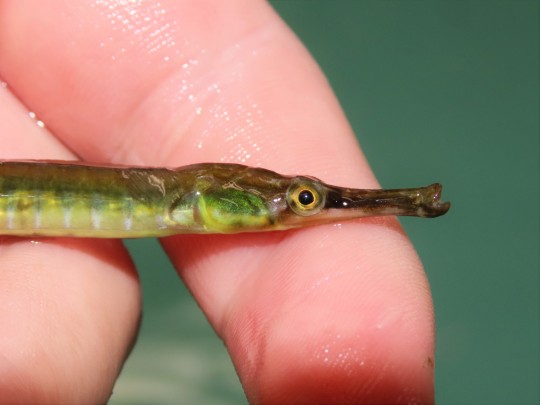
Centropristis striata, Pomatomus saltatrix, Tautoga onitis, Syngnathus fuscus
-09/23, Ocean County, NJ
206 notes
·
View notes
Text


Soverato, Calabria, Italy
Soverato is known above all for its enchanting blue sea, but not many people know that the bay of Soverato is home to many protected species.
Two species of seahorses can usually be found in the bay of Soverato: the Hippocampus hippocampus and the , both in danger of extinction and included in the CITES list - "Convention on International Trade in Endagered Species of Wild Fauna and Flora".
In ecology, seahorses are considered a valid indicator of environmental quality, since they are sedentary organisms that live in habitats in a state of natural equilibrium.
In the bay of Soverato the pipefish (Syngnathus abaster) and the large-shelled mollusc Tonna galea, can also be found. Both fishes are included in the protection list of the Bern Convention.
Follow us on Instagram, @calabria_mediterranea
#Soverato#calabria#italy#italia#south italy#southern italy#mediterranean#mediterranean sea#sea#seahorse#hippocampus#beach#beaches#italian#europe#landscape#italian landscape#landscapes#seascape#seaside#seashore#sand#underwater
43 notes
·
View notes
Text





some pretty Syngnathus abaster!
somewhere on the Bulgarian riveebank of the Danube
3 notes
·
View notes
Text
SYNGNATHUS (PIPE FISH)
Introduction The genus Syngnathus, commonly known as pipefish, represents a unique group of marine and estuarine fishes within the family Syngnathidae, which also includes seahorses and sea dragons. Pipefish are characterized by their slender, elongated bodies, tubular snouts, and prehensile tails, making them some of the most distinctive species in marine ecosystems. Their name, derived from…
0 notes
Text



Topfbauch- oder Dickbauch-Seepferdchen & Große Seenadel
Big-belly or pot-bellied seahorses & Greater pipefish
Hippocampus abdominalis & Syngnathus acus
[Aquarium Wilhelmshaven, 02.09.2024]
#TopfbauchSeepferdchen#DickbauchSeepferdchen#Bigbellyseahorse#Potbelliedseahorse#Hippocampusabdominalis#Seepferdchen#Seahorse#GroßeSeenadel#Greaterpipefish#Syngnathusacus#Seenadel#Pipefish#AquariumWilhelmshaven#Wilhelmshaven#Aquarium
0 notes
Text
it does indeed! the short answer is that the anglerfishes (Lophiiformes: Ceratioidei) who practice sexual parasitism (only maybe two dozen out of over 170 species)[1] mostly don’t have adaptive immune systems anymore, jettisoning anywhere from half to all of the major histocompatibility complex genes and a lot of the code for T and B cell proteins.[2] while it’s not unheard of for modern bony fishes to drop the MHC class II genes for various reasons (pipefish[3], cod[4], a single monkfish[5]), the general trend is for them to have a far more diverse set of MHC class I genes than mammals do[6]. except in the deep sea, where exists a lanternfish (Benthosema glaciale) sans its mhc1u lineage[4] and the ceratioid anglerfishes.
anglerfishes who practice sexual parasitism have a significant contraction of the MHC class I genes and are missing the proteins that let T cells interact with MHC class I molecules, and species that form consortial matings (2+ males, the record is the Queen of the Deep's eight, yeah this is a huge fucking deal from a histocompatibility perspective) also kick the class II genes as well as both rag1 and rag2 (genes whose absence causes the lethal state of severe combined immunodeficiency in mammals).[2] going hypothesis is that they might have hardwired some of the adaptive upregulation of the innate immune system known to occur in rag1-deficient zebrafish[7], which might explain how they don’t drop like flies from all the microorganisms in the abyssal zone[8] but is not a fully satisfactory explanation for the lack of allograft rejection response, given the differences in which pathways get dropped. Ceratias, a monogamous genus, dropped the mhc1u lineage but significantly expanded the mhc1z lineage,[2] so, like... what gives there? (yeah it does fucking kill my friends who actually work in this field that both in situ and in vivo study of this group are currently impossible, on account of the “lives six miles underwater” thing.)
separately, there’s a good chance immune response changes first and sexual parasitism follows afterwards: all the ceratioids have the famous exaggerated sexual dimorphism and all of them perform some form of attachment, but in most of them the male just bites down and hitches a ride for a bit, then lets go and moves on. given the relative lack of nutrients in the deep sea, the evolutionary trend may be for anglerfishes to drop immune infrastructure for metabolic cost reasons and for full-fusion sexual parasitism to arise to take advantage of it, which would explain why 1) sexual parasitism has evolved 3-5 separate times in this suborder[1], and 2) why Vanhöffen’s whipnose, which does not practice sexual parasitism, also doesn’t have a fucking adaptive immune system.[2]
1. Pietsch, T. W. Dimorphism, parasitism, and sex revisited: modes of reproduction among deep-sea ceratioid anglerfishes (Teleostei: Lophiiformes). Ichthyol Res 52, 207–236 (2005).
2. Swann, J. B., Holland, S. J., Petersen, M., Pietsch, T. W. & Boehm, T. The immunogenetics of sexual parasitism. Science 369, 1608–1615 (2020).
3. Haase, D. et al. Absence of major histocompatibility complex class II mediated immunity in pipefish, Syngnathus typhle: evidence from deep transcriptome sequencing. Biology Letters 9, 20130044 (2013).
4. Malmstrøm, M. et al. Evolution of the immune system influences speciation rates in teleost fishes. Nat Genet 48, 1204–1210 (2016).
5. Dubin, A., Jørgensen, T. E., Moum, T., Johansen, S. D. & Jakt, L. M. Complete loss of the MHC II pathway in an anglerfish, Lophius piscatorius. Biology Letters 15, 20190594 (2019).
6. Yamaguchi, T. & Dijkstra, J. M. Major Histocompatibility Complex (MHC) Genes and Disease Resistance in Fish. Cells 8, 378 (2019).
7. Tokunaga, Y. et al. Comprehensive validation of T- and B-cell deficiency in rag1-null zebrafish: Implication for the robust innate defense mechanisms of teleosts. Sci Rep 7, 7536 (2017).
8. Freeman, M. A. et al. Spraguea (Microsporida: Spraguidae) infections in the nervous system of the Japanese anglerfish, Lophius litulon (Jordan), with comments on transmission routes and host pathology. J Fish Dis 34, 445–452 (2011).
did you know that the well-known factoid that male anglerfishes degenerate after attachment until they’re basically just a pair of testes is false? i knew of course that they don’t just become “growths” on the female because I’ve handled dozens of attached pairs and every male I’ve ever seen has been very much obviously a whole and complete second fish, but I sort of assumed there was internal degeneration, perhaps muscle atrophy, etc. i can’t believe no one ever corrected me on this but this just doesn’t happen. in obligatorily parasitic species, the male actually continues to grow and increases considerably in size after he attaches to the female, because the two of them can only reach sexual maturity together. me, an octavia butler fan: is this the height of romance??
what is true is that attached males do have hugely enlarged testes proportionate to the rest of their bodies & organs, and that they receive all nutrition from the female’s bloodstream so their stomachs are always empty, though their own gills seem to still be functional, as are their fins and muscles—you can even induce movement and swimming motions on recently dead attached males. I can only assume that at some point someone said that basically the only biological function a male anglerfish needs to perform is sperm production and this got taken out of context and luridly exaggerated over time. he’s not just a pair of testicles! he’s her forever partner! one flesh one end!
#anglerfishes#long post#yeah i did just have all these on hand sorry ive been in the TRENCHES about this#about half of them are open source and you can find the rest on sci-hub
28K notes
·
View notes
Text
El rey del Mar Menor: el mújol
Había seleccionado ya las fotos de mújoles para esta entrada cuando he leído en La Verdad de hoy, el artículo de mi admirada (cuando sea mayor quiero escribir como ella) Alexia Salas, "La pesca del Mar Menor cae un 90% y la Cofradía teme tener que echar el cierre al no haber ingresos”. No me ha sorprendido en absoluto, aunque sí me ha entristecido y mucho, verlo en negro sobre blanco.
Desde mayo que me estoy sumergiendo en la laguna, no veo prácticamente vida de aquella que me maravillaba no hace tanto tiempo: no solo ha desaparecido el caballito de mar, ahora es también la aguja (Syngnathus abaster), el berberecho, la almeja, la nacra, el cangrejo mediterráneo…
Cuando digo vida, me refiero a la vida que estaba asociada al Mar Menor, porque vida no deseada no falta: toneladas de algas filamentosas (Chaetomorpha linum) se extienden sobre las praderas marinas que cubren lo que en otros tiempos eran arenales, y que hoy ya forman parte del paisaje sumergido.
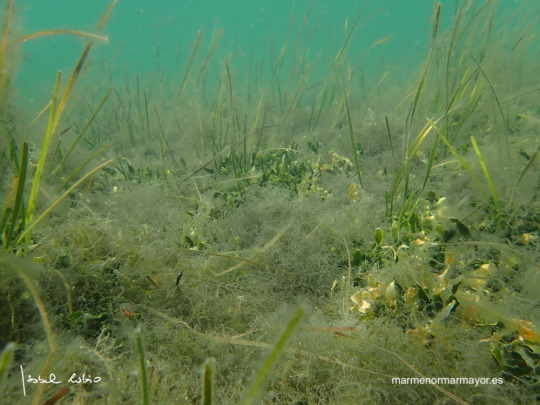
Agosto 2023
Y no hablemos de la aparición a finales de junio de millones de medusas (Cotylorhiza tuberculata) que parecen estar compensando los años en los que estuvieron ausentes, y de las andanzas del cangrejo azul que devora cuanto encuentra a su paso.
Mújoles buscando alimento en las algas filamentosas posadas sobre manchas de pradera
Pero como había decidido escribir sobre los mújoles –los peces más representativos y de tradición comercial del Mar Menor, al menos hasta el último cuarto del siglo XX–, sigo, apesadumbrada, poniendo aquí un pequeño resumen con la descripción de dos de estas especies del libro de F. Javier Olmos (1), y las fotos y pequeños vídeos que he hecho del pardete o mújol (Mugil cephalus) y de la liza o galupe (Chelon auratus).
Mújol o pardete (Mugil cephalus)
Una de estas especies de mugílidos es el mújol, llamado también pardete (Mugil cephalus), el de mayor tamaño de esta familia, que puede llegar a sobrepasar los 70 cm de longitud. Su cuerpo es alargado con cabeza ancha y boca estrecha en la que los ojos están cubiertos en su mayor parte por una membrana.
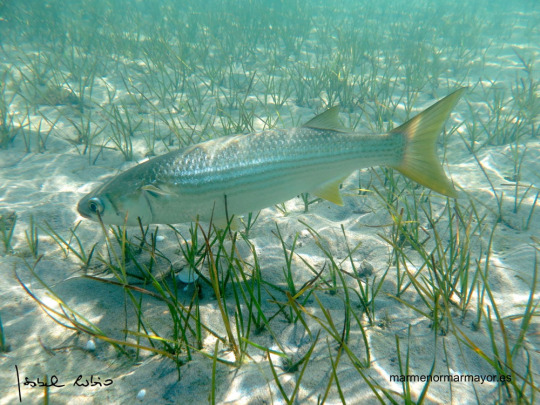
El dorso del pardete es de color gris plateado con tonalidades azul oscuro, el vientre blancuzco y las aletas amarillentas. El cuerpo está cubierto de grandes escamas, tiene una gran mancha amarilla dorada en el opérculo, aunque bastante difuminada, y una aleta caudal amplia y bifurcada.
Liza, lisa o galupe (Chelon auratus)
La liza, lisa o galupe es, junto con el pardete, uno de los mújoles de más calidad, aunque de tamaño menor, pues sólo llega a los 35 cm. Es muy parecida al anterior: la mancha amarilla del opérculo, más marcada que en el pardete, le da el nombre científico de “Chelon auratus”. La cabeza es más estrecha y las aletas pectorales más largas que en las restantes especies de la familia de los mugílidos.
La coloración del dorso es pardusca o grisácea, con los flancos plateados y con bandas longitudinales más o menos oscuras, y vientre blanquecino.
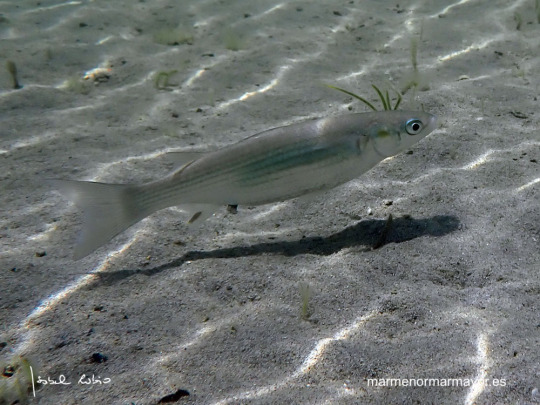
Hábitat, alimentación y reproducción
Los mújoles viven en aguas superficiales y suelen ir en pequeños o grandes grupos. En el Mar Menor se le puede ver en zonas rocosas o en fondos de arena, fango y sobre praderas de algas y fanerógamas.
Ambas especies se alimentan de materia orgánica, plancton, detritos y microorganismos del fango que ingieren constantemente.
Viven en el Mar Menor aproximadamente hasta los tres años, que es cuando alcanzan la madurez sexual, pero la freza tiene lugar en el Mediterráneo durante los meses de agosto a noviembre. Después, una parte de las larvas y alevines cruzan de nuevo las golas y atraviesan las encañizadas para desarrollarse posteriormente dentro de la laguna. Cuando en el pasado intentaban cruzar las golas para la reproducción en el Mediterráneo a finales de agosto y septiembre, se producían grandes capturas en las encañizadas.

Interés comercial del mújol
Los mújoles tienen valor comercial por la calidad de su carne, y en el caso del pardete, además, por sus huevas, que son muy apreciadas. Están muy presentes en la gastronomía local: caldero, a la sal...
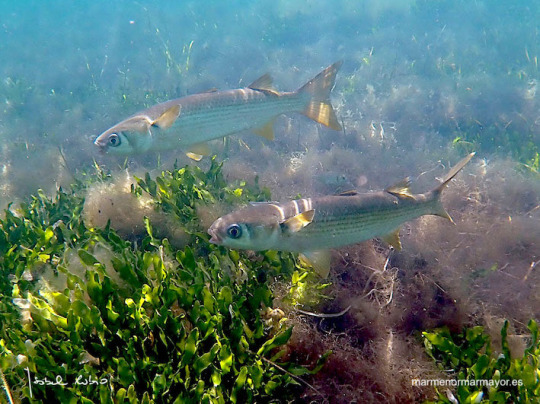
Servicios ecosistémicos del Mar Menor
El Mar Menor no solo nos regala un paisaje increíble, produce bienestar, mejora nuestra salud, nos permite la práctica de deportes de vela…, sino que también proporciona recursos económicos, como el de la pesca, de la que todavía viven más de 100 familias, aunque no se sabe por cuánto tiempo debido a la drástica bajada de capturas.
Abrazo al Mar Menor
Termino esta entrada al día siguiente de empezarla, el día en el que miles de personas hemos rodeado al Mar Menor para darle un abrazo. Aunque otros consientan su maltrato, nosotros lo defendemos.
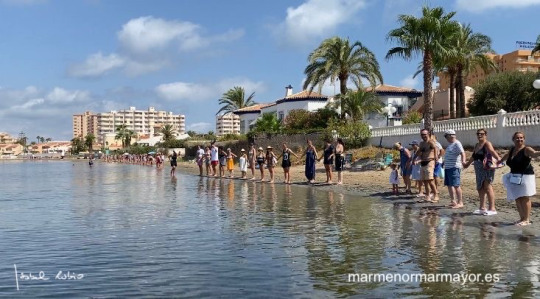
Abrazo al Mar Menor 2023
------------------------------------
Otros mugílidos en el Mar Menor
Para saber más de estas y de otras especies con el nombre de liza (2) (Chelon labrosus), morragute (Chelon ramada), y galúa (2) (Chelon saliens), os recomiendo consultar el libro de F. Javier Olmos, cuyo PDF podéis descargar en el enlace.
-----------------------------------------
(2) Nota: el nombre vulgar de las especies varía de una localidad a otra, por eso es importante poner el nombre científico para evitar confusiones.
-----------------------------------------
Fuentes consultadas
(1) Olmos García, F.J. (2019): Las especies comerciales en la laguna del Mar Menor. Galpemur
Gómez Escudero, J.A. (2021): Toda una vida en la pesca. Círculo Rojo
0 notes
Text
Cavalos-marinhos resgatados em 2022 na Trafaria devolvidos à natureza
Os cavalos-marinhos que em março de 2022 foram recolhidos na zona da baía da Trafaria, no concelho de Almada, e acolhidos no Oceanário de Lisboa, foram devolvidos ao seu habitat natural, foi hoje anunciado.

"A ação decorreu no passado dia 31 de outubro, foi coordenada pelo ICNF -- Instituto da Conservação da Natureza e das Florestas, e envolveu o Oceanário, o MARE-ISPA, devidamente licenciados para a translocação dos cavalos-marinhos, e a Câmara Municipal de Almada", revela o ICNF em comunicado.
A devolução dos cavalos-marinhos foi feita em mergulho na zona da Trafaria, no distrito de Setúbal.
Segundo o ICNF, este núcleo populacional de cavalos-marinhos é das espécies Hippocampus hippocampus e Hippocampus guttulatus.
Após o resgate em março de 2022 na sequência do colapso de um pontão na Trafaria, os cavalos-marinhos foram acolhidos pelo Oceanário de Lisboa, onde permaneceram até agora.
A intervenção de 2022, ainda de acordo com o instituto, "permitiu recolher cinco marinhas (Syngnathus acus) e 23 cavalos-marinhos, das duas espécies ocorrentes em Portugal (quatro cavalos-marinhos comuns, Hippocampus hippocampus, e 19 cavalos-marinhos-de-focinho-comprido, Hippocampus guttulatus)".
"As marinhas, que entretanto se haviam reproduzido, permitiram devolver mais de 100 indivíduos no passado mês de março", acrescenta o ICNF.
Na nota, o instituto salienta que "as espécies Hippocampus hippocampus e Hippocampus guttulatus têm graves problemas de conservação, necessitando de medidas de proteção específicas e urgentes, o que fez com que já estejam listadas nos anexos da CITES (Convenção sobre o Comércio Internacional de Espécies da Fauna e da Flora Selvagem Ameaçadas de Extinção) e no Regulamento Comunitário, que aplica essa convenção na União Europeia".
As duas espécies foram também incluídas nos anexos do decreto-lei que aprovou o regime jurídico aplicável à proteção e à conservação da flora e da fauna selvagens e dos habitats naturais das espécies enumeradas nas Convenções de Berna e de Bona, acrescenta ainda o instituto.
0 notes
Note


Found this funky lil fish on onset capecod, also happy wildlife day
FUNKY LIL FISH ID - CAPE COD, MA, USA:
Oh hey there, you have a pipefish there. Its hard to tell from the darkened coloration, but in that area the safest bet is Northern Pipefish (Syngnathus fuscus), family Syngnathidae, order Syngnathiformes.
179 notes
·
View notes
Note
Can we get a fish that looks like an alien of some kind?
Snoot-maxxing

You get a Greater Pipefish
Syngnathus acus
71 notes
·
View notes
Text

You get a Greater Pipefish
Syngnathus acus
The problem with having your recreational and work activities on the same platforms is the above zero chance of you accidentally using your work account to report your calculations of your average rates of cabbage consumption.
931 notes
·
View notes
Text
Een grote zeenaald

Een rariteit in het vloedmerk
Op maandag 12 oktober 2020 vond ik tijdens een wandeling over de Zandmotor bij Ter Heijde een schepsel in het vloedmerk dat ik nog nooit eerder met eigen ogen had mogen aanschouwen. Ik kende het wezen slechts van afbeeldingen uit mijn standgidsen en visboeken. Omdat het beest een rariteit betrof en ondanks dat het dood was in uitstekende staat verkeerde, besloot ik het mee te nemen. Hoe ik het precies ging conserveren dat was voor latere zorg: dat kwam wel goed.
Een algemene vis
Ik dacht dus dat de zeenaald een zeldzaamheid was: ik had er tenslotte nog nooit eerder een gezien. Maar niets is minder waar, de zeenaald en in het bijzonder de soort die ik vond, de grote zeenaald (Syngnathus acus) , is een algemene soort in onze Noordzee. Dat ik, en u waarschijnlijk ook, er zelden een tref heeft vooral te maken met zijn bijzondere bek en commerciële waarde. Door zijn buisvormige snuit waarmee de zeenaald slecht kleine garnaaltjes en larven naar binnen kan zuigen, is de kans buitengewoon klein dat de vis door een sportvisser aan de haak wordt geslagen. Ook de kans dat de beroepsvisserij een zeenaald binnen takelt is gering. Zeenaalden glippen gemakkelijk door de mazen van het net. En mocht er een blijven hangen, dan nog zult u het beest uiteindelijk niet achter de toonbank treffen. De zeenaald heeft namelijk, in tegenstelling tot zijn neef, het zeepaard, die in gedroogde vorm nog lekker over de toonbank gaat, totaal geen economische waarde.

Op deze afbeelding is duidelijk te zien waaraan de zeenaalden hun genusnaam te danken hebben. Syngnathus is afgeleid van het Grieks en betekent "samengevoegde kaak".
Conserveren
Maar goed, zeldzaam of niet, ik had het beest al mee naar huis. En nu moest het geconserveerd worden. Maar hoe? Omdat het mij in dit geval om de buitenkant ging, het merkwaardige uiterlijk moest bewaard blijven, viel een pot in de achtertuin af. Wat mij betreft bleven er twee opties over: of drogen of op sterk water. Omdat ik de kunst van het drogen niet machtig ben, besloot ik voor het laatste te gaan. Dat had ik al eens eerder gedaan met wat schelpdieren.
Nu had ik een ten opzichte van de schelpdieren wel een ‘kleine’ uitdaging: hoe kwam ik zo snel aan een glazen pot waar ik het ruim 39 centimeter lange beest in kon bewaren en hoe kwam ik zo snel aan de nodige hoeveelheid sterk water. De pot werd uiteindelijk de fles van de olijfolie en voor de alcohol plunderde ik bij het Kruidvat de voorraad kleine flesjes Alcohol Kentonatus 96%.

De geconserveerde grote zeenaald. Aan de broedzak te zien betreft het een manlijk individu. net als bij zeepaarden broed de mande eitjes uit nadat hij die van de vrouw heeft ontvangen.
Met een beetje passen en meten kreeg ik de zeenaald op een toonbare manier in de fles. Tevreden vulde ik de fles tot aan de rand met de alcohol, schroefde de dop er op, maakte een mooi kaartje met de nodige informatie en leunde tevreden achterover. Voor even. Een minuut later besefte ik me dat ik zeenaald verkeerd om had gepositioneerd. De karakteristieke zwemhouding van de zeenaald is namelijk met de kop omlaag! Maar goed, ik had geen zin in gedoe en daarom besloot ik: gedane zaken nemen geen keer, althans dit keer niet.

2 notes
·
View notes
Text

Syngnathus euchrous Chocolate pipefish
368 notes
·
View notes